
THIS BLOG POST IS WRITTEN WITH THALIA R. GOLDSTEIN, PROFESSOR AT PACE UNIVERSITY IN NY.
Star Wars aficionados will not like this post. We took our 10-year-old grandson to see Rogue One yesterday and I keep kicking myself that we stayed. I asked him if he understood what was going on several times and he didn't. I didn't get it either. This movie felt hollow - as did the characters. Take the main character. There is no comparison between the beloved Princess Leia (rest in peace dear Carrie Fisher) and Jyn Erso. The Princess was a real person with wit and values who could speak in longer than angry monosyllabic utterances - hence her longevity with the public and a model for girls - remember all those Halloween costumes? No one will want to play at being Jyn. Hard bitten and violent, she rarely shows emotion and is remarkably unidimensional.
And she often communicates through violence. Okay okay, I know the series is called "Star Wars." And I do not uniformly avoid movies with violence as some make points worth fighting for. But the majority of Rogue One was battle scenes, both aerial and on the ground, and none of it seemed clearly motivated. Furthermore, what is the difference between shooting someone with a laser versus a gun? Both result in bodies on the ground. But even worse, because many of the soldiers are dressed like large white porcelain toasters, the children present are not confronted with the true outcomes of violence. Fighting with a laser or a gun takes someone out. No blood doesn't mean no suffering and no death. Parents would hesitate before taking a child to a boxing match. Perhaps parents discount the violence on the screen because it is bloodless. Furthermore, the few humans who were shot do not make up for the thousands of "toasters" kids saw drawing fire and 'dying.' And we don't know what kids think are inside the toasters: Are they real people? Robots?
I watched my gentle 10-year-old trying to make sense of what he was seeing. He is a big LEGO user so undoubtedly built some of the planes and structures he saw on the screen. But he was flat - both during the movie and after - not really understanding what all the fighting was about. The theatre was filled with kids, and kids much younger than 10. Children's developing understanding of plot takes a long time and jolts of violence make the story even harder to follow.
Why does our culture insist on creating violent war films for kids who can't yet handle a sharp knife? Why are we the purveyors of death and destruction? Is it any wonder that children die by accident at the hands of other children wielding guns? Media portrayals of consequence-free violence do not help children understand how real guns can cause havoc and lasting pain. In the year 2015, more than 265 children shot someone by accident, likely related to the fact that nearly 1.7 million children live in homes where guns are not locked away and worse -- stored loaded according to the San Francisco-based Law Center to Prevent Gun Violence. Compared with other countries, American children are therefore 16 times more likely to be unintentionally killed by a gun.
Years of psychological research have revealed that violence breeds violence http://bit.ly/2ihvy34 and http://bit.ly/2ibwsQO Children who witness real violence are more likely to engage in violent behavior themselves in the future. Joy and Howard Osofsky, at the Louisiana State University Medical School, are experts on the impact of violence on children. Fictional violence - like that seen on television, movies, and the internet -- is problematic because kids' understanding of actors and acting is not fully developed. Many don't get that you can take off the toaster suit and the grungy make-up and turn into an everyday person again. As the Osofskys wrote,
"Glamorization of make-believe violence is dangerous, and those who manufacture it must bear some responsibility when youngsters model the inappropriate behaviors they see portrayed in front of them. ... adults who convey stories about violence to audiences that are likely to include children should avoid characterizations that encourage risk-taking, promote the seeking of revenge, or possibly will lead to copycat behavior." http://bit.ly/2ilioVh
Before you take your child to violent movies, remember how we are affected by violent movies - we can't tell the difference either between reality and fantasy either. Romantic movie? Our hearts beat aflutter and we feel romantic. Violent movie? Our hearts pound in anticipation and fear. When theatre and film can be so magical for children, bringing them into whole new fantastical worlds, why show children violence? Watching children watching violence is not worth the price of the ticket.